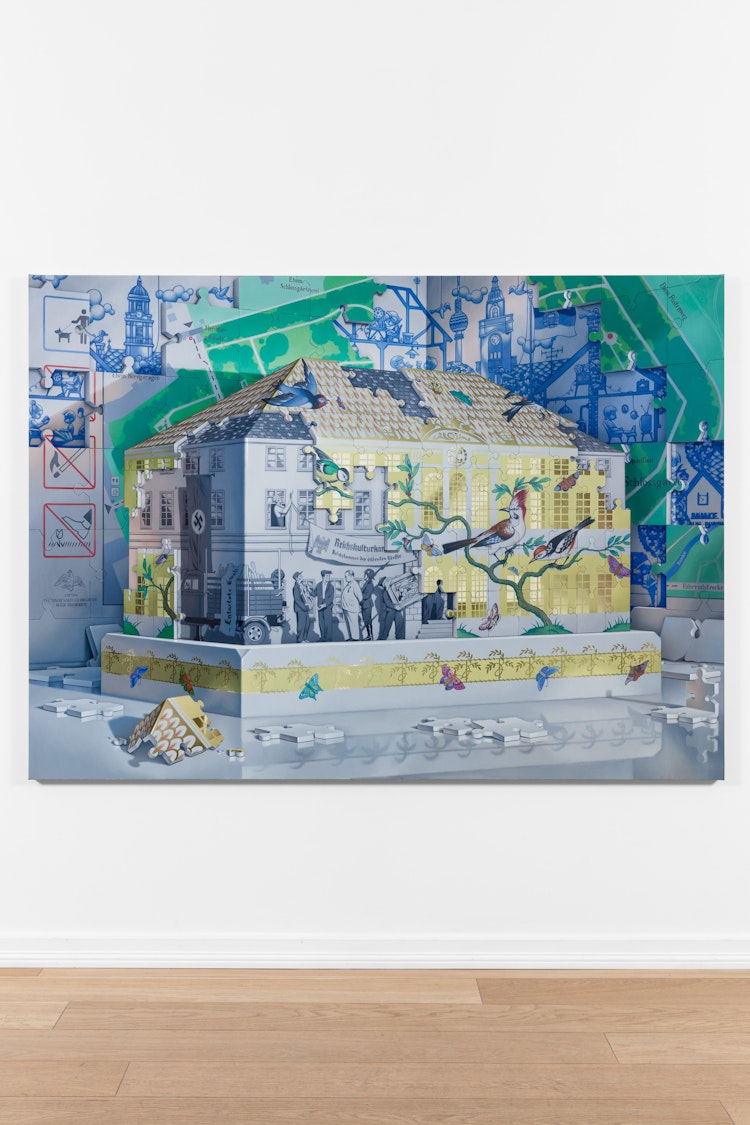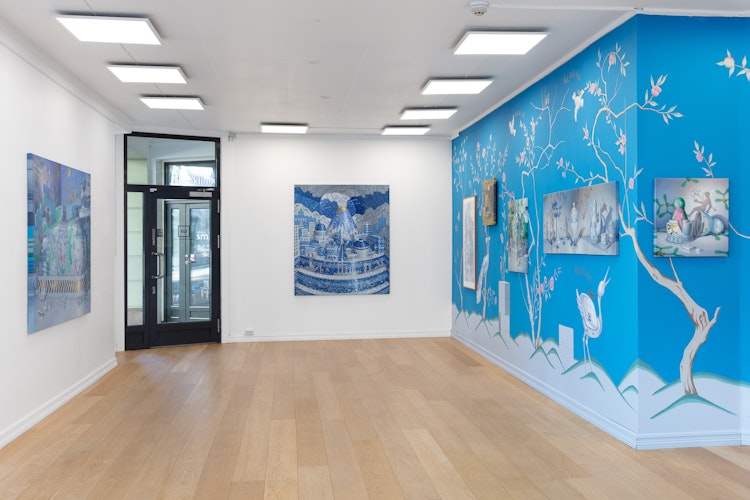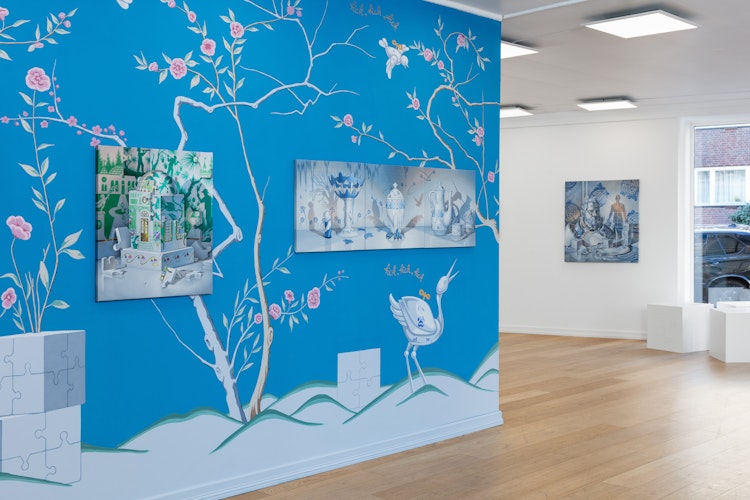Mirrorscape


The exhibition opens Friday the 20th of September from 6 - 8 pm
-
To write about Bjørn Båsen
If you Google texts about Bjørn Båsen, a lot of strange things pop up. It's as if those of us tasked with writing about Båsen are gasping for air, searching for the right words to describe the overwhelming amount of details, intricate compositions, and the boundary-crossing between styles and aesthetics, between good and bad taste.
Here are some disjointed quotes about Båsen's art, presented without sources: "video games and fantasy meeting the grandeur and decadence of the Baroque." "Characterized by ornamentation, complexity, and a personal mythology; the works appear as a blend of the grotesque and the decadent." "Full of references to mythology, the decadence of both past and present, fairy tales, and realism." "A sophisticated and saccharine sweet sensibility, referencing the ornate approach of masters such as Watteau and Boucher in the Late Baroque period, as well as the kitschy aesthetic of contemporary Japanese painting by artists such as Takashi Murakami and Yayoi Kusama."
It's as if Båsen's works evade straightforward sentences, mirroring his aesthetics. The moment you think you've captured the piece, it's as if your gaze slides onto yet another detail. There are so many, and at times they contradict one another. It’s not easy to grasp what one should extract from these works.
Let’s begin with one. Is it a whale? Or is it a submarine, decorated with motifs from the Middle Ages? And that silk screen print of a stove, is it also an image of an oil rig? I think so.
In another picture, there’s a house with a dome, an orangery, and in the background, you can see a botanical expedition with two (white) Europeans leading and a local (black) carrying something. Inside the house in the foreground are the plants the Europeans brought back for their Colonial Collection. But something is strange with the plants – they are carnivorous and devouring the Europeans. It’s 1950s horror film meets 19th-century colonialism.
The triptych featuring porcelain is inspired by Gerhard Munthe’s "Blåveis" motif. If you look closely, you can read an excerpt from Munthe’s 1919 book Minder og Meninger. According to the Norwegian Biographical Dictionary, the book is "essentially a collection of newspaper articles, often written on short notice and by request, and does not form a cohesive or easily interpretable art philosophy." Even the quote is from an obscure context, difficult to interpret.
Another image shows Schloss Schönhausen in Berlin, and – trigger warning – it features a swastika. During the Nazi era, so-called "degenerate art" was stored in this building. Later, it became the headquarters of the communist regime in East Germany. The building is also known as the home of Elisabeth Christine of Brunswick-Wolfenbüttel-Bevern—Frederick the Great’s wife. Frederick himself was passionately homosexual, and while he enjoyed the company of men, the queen took over monarchical duties. The outer layer of birds is taken from her China breakfast porcelain. Behind it is a DDR landscape and a copy of today's tourist map.
And so it continues, picture after picture. Layer upon layer of stories and myths, digressions across centuries, history’s backside and flipside intertwined. There are no clear signals of when Båsen is joking or when he’s serious. The technical brilliance and aesthetic appeal of the images’ surfaces overwhelm us. The pictures are an aesthetic exploration of just how messy the past really is, a fascination with history’s mazes. An uncovering of historical paradoxes and strange coincidences. And for that, we should be thankful.
One of the scariest things is simplistic and straightforward portrayals of history. When history leading up to the present is told as if driven by a single will, motivated by one clear goal, or as the result of individual decisions. Through oversimplified descriptions of history, one can assign blame, obscure power, or create enemies. Simplified history writing is used to maintain conspiracy theories, polarized debates, and escalate conflicts.
It is human to want to explain a past story as neatly as possible. By stripping away the past, cutting out what doesn’t fit, focusing on certain elements in a specific sequence, one gets a story that feels logical and correct. The problem is, history has never been simple! History’s course has just as much been shaped by coincidence, luck, or happenstance, as by calculated actions or will. There was power unseen at the time, decisions we can’t understand today, and cause-and-effect that don’t feel intuitive.
In addition, people have always initiated projects that amounted to nothing, decisions ended up leading nowhere, resolutions weren’t followed through, plans fell through, and inventions that could have changed the world were forgotten. At the same time, history is full of relatively small actions that ended up pushing history in an entirely different direction than anyone could have foreseen seconds before. The shots in Sarajevo. The shots in Dallas. When an East German state official misread a document at a press conference, and the Berlin Wall fell in a single night. Other times, small coincidences and conditions in topography, timing, and force have determined parts of history’s course. Meanwhile, an entirely different story was unfolding elsewhere in the world.
In short, history has not been simple. The present is never simple either. We always live in a backdrop of old times—through buildings, structures, laws, texts, ideologies, norms, language, and families constructed in earlier times. At the same time, the future crashes over us, like a flicker or a wind we cannot stop. It has always been this way. There has never been a simple past; no one has ever lived in a simple history. None of us live in a simple time, and humans never have.
The world is always chaotic and confusing; where power truly lies is not always easy to see, and the direction of everything only becomes clear in retrospect. The most honest way to convey this past, the one for which it’s difficult to find words, is what Båsen in this exhibition, invites us into.
- Bjørn Hatterud
















What are you looking for?